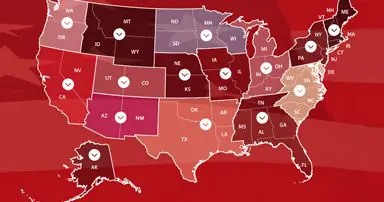Pets, farm animals and livestock rely on their humans to protect them and keep them safe in all types of emergencies. It’s important to have a plan in place ahead of severe weather and other disasters to protect your animals and livestock. The following checklists are designed to help farmers and other pet owners better prepare for evacuating and caring for animals in a disaster.
Basic Disaster Preparation:
- Assemble an evacuation kit (see below).
- Develop an evacuation plan for all of your animals and practice the plan.
- Keep written directions to your home near your telephone. This will help you and others explain to emergency responders exactly how to get to your home.
- Identify alternate sources of food and water. Because flood waters are often contaminated with sewer waste and may also pose a risk of chemical contamination, animals should be prevented as much as possible from accessing and drinking from those sources.
- Have well maintained backup generators and a source of fuel for use in food-animal production operations.
- Keep vehicles well maintained and full of gas.
- Keep emergency cash on hand. (Remember: ATMs may not work.)
- If evacuating is impossible, decide on the safest housing option for your animals, realizing that the situation is still life threatening.
- Assess the stability and safety of barns and other structures, promptly remove dead trees, and minimize debris in fields and the immediate environment.
- If you live in an area prone to wildfires, clear away brush and maintain a defensible space around structures.
- Keep a list of the species, number and locations of your animals near your evacuation supplies and note animals’ favorite hiding spots. This will save precious rescue time.
- Ensure your animals have proper identification such as:
- microchip
- tattoo
- halter tag
- neck collar
- leg band
- brand
- mane clip
- luggage tag braided into tail or mane
- clipper-shaved information in the animal’s hair
- livestock marking crayon, non-toxic, non-water-soluble spray paint, or non-water soluble markers to write on the animal’s side
- permanent market to mark hooves
- neck chain
- ear notches
- leg band
- ear tag
- wattle notching
- back or tail tag
Evacuating large animals
Equine and livestock evacuation can be challenging. Develop an evacuation plan in advance and make sure animals are familiar with being loaded onto a trailer. Locate and prearrange an evacuation site for your animals outside your immediate area. Possible sites include:
- veterinary or land grant colleges
- racetracks
- show grounds
- pastures
- stables
- fairgrounds
- equestrian centers
- livestock corrals
- stockyards or auction facilities
- other boarding facilities
If you do not have enough trailers to quickly transport all of your animals to an evacuation site, contact neighbors, local haulers, farmers, producers or other transportation providers to establish a network of available and reliable resources that can provide transportation in the event of a disaster.
If evacuation of horses/livestock is impossible, relocate them to the safest place possible based on the type of imminent disaster and the environment, realizing that the situation could be life threatening. Make sure they have access to hay or another appropriate and safe food source, as well as clean water and the safest living area possible, including high ground above flood level. Do not rely on automatic watering systems, because power may be lost.
The decision to leave your horses/livestock in the field or in the barn should be based on the risks of injury resulting from the disaster and from the immediate environment during that disaster. Factors to consider include the stability of the barn, the risk of flooding and the amount of trees and debris in the fields. If time permits, secure or remove all outdoor objects that could turn into dangerous flying debris.
Equine and livestock evacuation kit
- 7–10 day supply of feed, supplements, and water
- Bandanas (to use as blindfolds)
- Batteries (flashlight, radio)
- Blankets
- Copies of veterinary records and proof of ownership
- Cotton halter
- Duct tape
- Emergency contact list
- First aid kit
- Flashlight
- Fly spray
- Grooming brushes
- Heavy gloves (leather)
- Hoof knife
- Hoof nippers
- Hoof pick
- Hoof rasp
- Instructions
- Diet: record the diet for your animals.
- Medications: list each animal separately, and for each medication include the drug name, dose and frequency. Provide veterinary and pharmacy contact information for refills.
- Knife (sharp, all-purpose)
- Leg wraps and leg quilts
- Maps of local area and alternate evacuation routes in addition to GPS (in case of road closures)
- Non-nylon halters and leads (leather/cotton)
- Nose leads
- Paper towels
- Plastic trash cans with lids (can be used to store water)
- Portable livestock panels
- Radio (solar, hand cranked and/or battery operated)
- Rope or lariat
- Shovel
- Tarpaulins
- Trash bags
- Twitch
- Water buckets
- Whip/prods
- Wire cutters
Evacuating backyard poultry
- Be sure to include birds in your disaster plans. Plastic poultry transport crates/coops work well for transporting chickens if evacuation is necessary. Vehicle interiors should be warmed in winter or cooled in summer before transporting birds.
- Transfer birds to more suitable housing as soon as possible to facilitate feeding and watering. Line crates or cages with shavings or other absorbent material for ease of cleaning. At the evacuation site, house birds away from noisy areas and other flocks, and protect them from the weather and predators.
Backyard poultry evacuation kit
- Leg bands with an emergency telephone number and photos of birds can help you identify them if they escape or get lost.
- Feed and water for 7–10 days. Vitamin and electrolyte packs (stress packs) may help ease stress.
- Sufficient feeders and waterers for the number of birds.
- Detergent, disinfectant, gloves and other cleaning supplies for cleaning cages.
- Feeders and drinkers.
- Extra absorbent bedding material (newspapers can work temporarily) to line cages or temporary coops.
- If evacuating chicks, consider their special needs (heat, food, equipment).
Additional contacts for equine and livestock owners
- State veterinarian
- State veterinary colleges or land grant colleges of agriculture
- Private stables/farms
- County Extension office; especially important for livestock owners
- Brand inspector, if applicable
- State and county livestock associations
- Racetracks
- Fairgrounds
- Show grounds
- Stockyards
- Equestrian centers
- Local haulers or neighbors to help with transportation
- Feed distributor
- American Association of Equine Practitioners
- American Association of Bovine Practitioners
- American Association of Small Ruminant Practitioners
- American Association of Swine Veterinarians
- USDA-APHIS District Director/Assistant Director
Have A Plan For Your Horses
The following information has been provided courtesy of the Humane Society of the United States.
- Call your county and ask if they have an emergency shelter or location for animals.
- Call local animal control to flag your property so it’s on the radar of emergency officials for assistance.
- If you have a horse or large animal at a boarding facility or barn, ensure there is a disaster plan in place to notify owners and or provide evacuation, if necessary.
- Ensure locks on barn doors are operational and easily opened in the event of an emergency.
- Ensure you have enough vehicles/trailers to move the number of horses at your facility.
- Permanently identify each horse by tattoo, microchip, brand or photograph. In your records, include the horse’s age, sex, breed and color. Keep this information with your important papers.
- Keep halters ready for your horses. On each halter, attach a luggage tag with the following information: the horse’s name, your name, email address, your telephone number and another emergency telephone number where someone can be reached. At the time of evacuation, consider additional temporary identification, such as a leg band.
- Place your horses’ Coggins tests, veterinary papers, identification photographs, and vital information—such as medical history, allergies and emergency telephone numbers (veterinarian, family members, etc.)—in a watertight envelope. Store the envelope with your other important papers in a safe place that will be easy for you to access, so you can take them with you when you and your horses evacuate.
- Make arrangements in advance to have your horse trailered in case of an emergency. If you don’t have your own trailer or don’t have enough room in your trailer for horses, be sure you have several people on standby to help evacuate your horses. Check with local haulers for availability during emergencies. When using emergency transport by unknown haulers during the emergency, collect contact information, vehicle identification, license plate and driver’s license.
- Practice loading your horses into a trailer so they become comfortable with the procedure.
- Have a back-up plan in case it’s impossible to take your horse with your when you evacuate. Consider different types of disasters and whether your horses would be better off in a barn or loose in a field. Your local humane organization, agricultural extension agent, or local emergency management agency may be able to provide you with information about your community’s disaster response plans.
- Share your evacuation plans with friends and neighbors. Post detailed instructions in several places—including the barn office or tack room, the horse trailer, and barn entrances—to ensure emergency workers can see them in case you are not able to evacuate your horses yourself.
- Prepare a basic first aid kit. Be sure to include enough water (12 to 20 gallons per day per horse), hay, feed and medications for several days for each horse.
- Evacuate as soon as you can; if you wait until the last minute to evacuate, emergency management officials may tell you that you must leave your horses behind.
Evacuating without your equines
- If you are evacuating without your equines, let your large animals out into a paddock or corral and cut off their access to return to a barn or stall (they will naturally retreat to where they are fed or cared for, even if the structure is on fire).
- In extreme danger with limited time, let your horse or large animal into a larger enclosed area that has been tamped down and is out of the line of fire. Ensure the safety of first response personnel by not allowing the horses to run free.
- Remove halters. The synthetic fibers can melt on their faces and the metal rings can get hot and burn them as well. They can also get caught on something in their panic to run or injure themselves attempting to get loose.
Equines and floodwater
Floodwater is dangerous to swim through with hidden obstacles beneath the water, live electrical wires and unpredictable currents. Although horses and other livestock can swim, exhausted animals can drown. Do not attempt to swim them long distances through floodwaters. If high ground is nearby, provide them with fresh, clean water and notify emergency management of their location for rescue when the waters recede.
Equines and barn fires
Most barn fires are preventable and too often they result from negligence or apathy toward fire prevention. Preventing barn fires and being prepared in the event of a fire can mean the difference between life and death for your livestock. Knowledge of the danger of fires and how to deal with them is essential, and vigilance is key to prevention.
How to prevent a barn fire
- Prohibit smoking in or around the barn. A discarded cigarette can ignite dry bedding or hay in seconds.
- Avoid parking tractors and vehicles in or near the barn. Engine heat and backfires can spark a flame.
- Store other machinery and flammable materials outside the barn.
- Inspect electrical systems regularly and immediately correct any problems. Rodents can chew on electrical wiring and cause damage that quickly becomes a fire hazard.
- Keep appliances to a minimum in the barn. Use stall fans, space heaters and radios only when someone is in the barn.
- Be sure hay is dry before storing it. Hay that is too moist may spontaneously combust. Store hay outside the barn in a dry, covered area when possible.
- Reinforce your house, barn and outbuildings with hurricane straps and other measures. Perform regular safety checks on all utilities, buildings and facilities on your farm.
- Use only native and deep-rooted plants and trees in landscaping (non-native plants are less durable and hardy in your climate and may become dislodged by high winds or broken by ice and snow).
- Remove all barbed wire, and consider rerouting permanent fencing so that animals may move to high ground in a flood and to low-lying areas during high winds.
- Install a hand pump and obtain enough large containers to water your animals for at least a week (municipal water supplies and wells are often contaminated during a disaster).
- Identify alternate water and power sources. A generator with a safely stored supply of fuel may be essential, especially if you have electrical equipment necessary to the well-being of your animals.
- Secure or remove anything that could become blowing debris; make a habit of securing trailers, propane tanks and other large objects. If you have boats, feed troughs or other large containers, fill them with water before any high wind event. This prevents them from blowing around and gives you an additional supply of water.
- If you use heat lamps or other electrical machinery, make sure the wiring is safe and that any heat source is clear of flammable debris.
- Label hazardous materials and place them all in the same safe area. Provide local fire and rescue and emergency management authorities with information about the location of any hazardous materials on your property.
- Remove old, buried trash, which is a potential source of hazardous materials during flooding that may leach into crops, feed supplies, water sources and pasture.
What to do in the event of a barn fire
- Immediately call 911 or your local emergency services.
- Do not enter the barn if it is already engulfed in flames.
- If it is safe for you to enter the barn, evacuate animals one at a time, starting with the most accessible ones.
- Never let animals loose in an area where they are able to return to the barn.
- Put a halter and lead rope on each horse when you open the stall door. Be aware that horses tend to run back into burning barns out of fear and confusion.
- Blindfold horses only if absolutely necessary. Many horses will balk at a blindfold, making evacuation more difficult and time consuming.
- Move horses to paddocks close enough to reach quickly but far enough from the barn that they won’t be affected by the fire and smoke.
- Be sure to have all your horses checked by a veterinarian after the fire. Smoke inhalation can cause serious lung damage and respiratory complications. Horses are prone to stress and may experience colic after a fire.
For Dogs, Cats, & Small Pets

























0 Comments